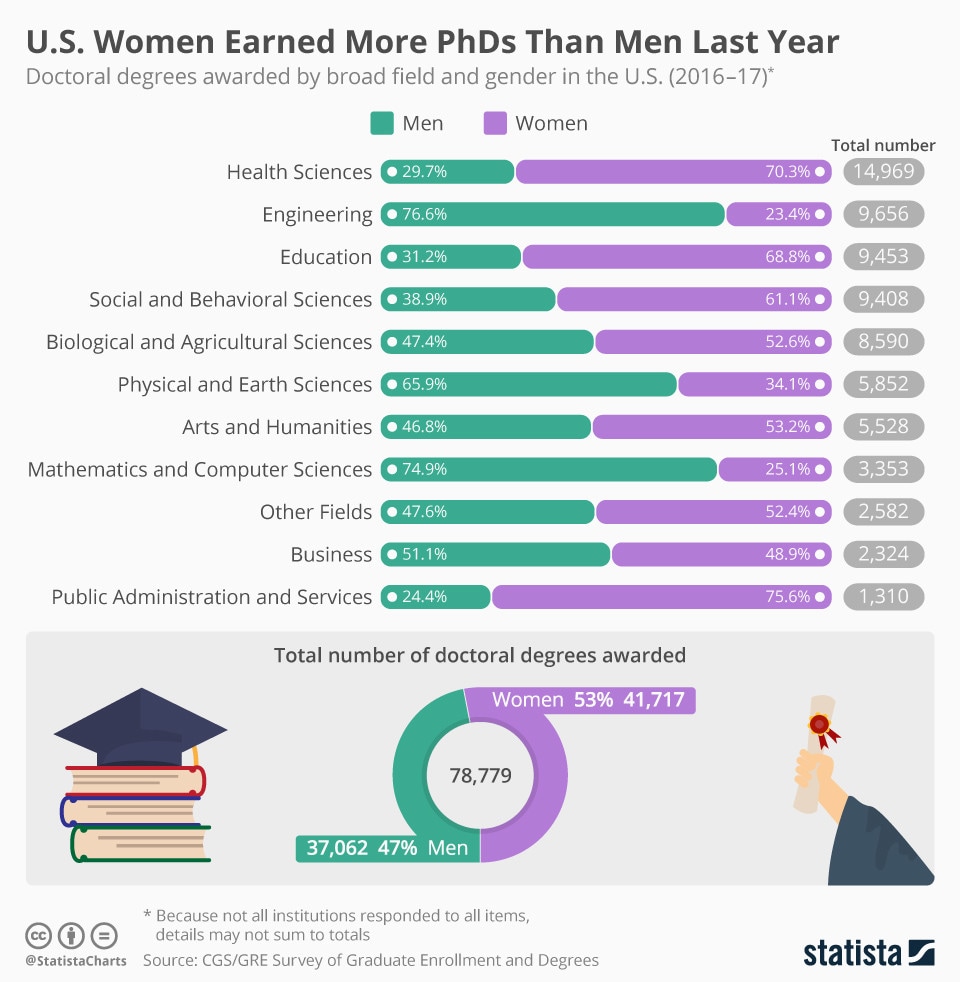Women were awarded more PhDs in the US than men last year

Men still earned the majority of PhDs in most STEM subjects
Image: REUTERS/Brian Snyder
Stay up to date:
United States
More than half (53%) of the 79,000 doctoral degrees handed out in the United States last year went to women – a record high.
But as the below chart shows, men still earned the majority of PhDs in most STEM (science, technology, engineering and maths) subjects.

For the ninth year in a row, women at US universities have earned more doctoral degrees than men, according to the Council of Graduate Schools’ CGS/GRE Graduate Enrollment & Degrees: 2007-2017 report.
In some fields, as many as three-quarters of the PhDs awarded went to women, including public administration and services (75.6%), health sciences (70.3%) and education (68.8%). Women were also ahead of men in arts and humanities, as well as social and behavioral sciences.
Besides doctoral degrees, US institutions also awarded the majority of graduate certificates (64%) and master’s degrees (57.3%) to women in 2016-17.
However, men still dominated in the fields of engineering (76.6%), mathematics and computer sciences (74.9%) and physical and earth sciences (65.9%), which suggests that more needs to be done to encourage women to study STEM subjects to a higher level.
Better educated, but not better paid

In November 2017, American wives were better educated than their husbands for the first time in history, according to the US Institute for Family Studies.
But despite the higher educational attainment of married women, they were still earning less than their husbands, or, as the Institute’s Wendy Wang said: “Even when women ‘marry down’ educationally, they continue to ‘marry up’ in income.”
Recent figures show that for every dollar earned by men, women earn just 80 cents. This is due in part to women tending to work in lower-paid industries, as well as a number of other factors including discrimination and bias in hiring and pay decisions. This is often compounded when women take time out of the workforce to raise children.
Getting more women into STEM
The US government reported that although women made up 47% of the workforce in 2015, they only occupied 24% of STEM jobs.
In 2016, just over one-quarter (25.5%) of computer and mathematical jobs were occupied by women, while only 14.2% of jobs in engineering and architecture were held by women.
STEM jobs are generally better paid – with women earning 35% more than those in other careers. But even those women in higher-paying STEM jobs were still earning less than their male counterparts, receiving just 79.2% of men’s annual median earnings in 2016.
So how to encourage more girls to study STEM subjects and take up careers in the field? Beyond striving for equality over pay and promotions in the workplace, suggestions range from creating all-female courses and online mentoring by women working in STEM, to changing the design of classrooms to make the actual learning environment feel more gender neutral.
Don't miss any update on this topic
Create a free account and access your personalized content collection with our latest publications and analyses.
License and Republishing
World Economic Forum articles may be republished in accordance with the Creative Commons Attribution-NonCommercial-NoDerivatives 4.0 International Public License, and in accordance with our Terms of Use.
The views expressed in this article are those of the author alone and not the World Economic Forum.
Related topics:
Forum Stories newsletter
Bringing you weekly curated insights and analysis on the global issues that matter.
More on Education and SkillsSee all
Laurel Taylor
August 18, 2025
Antara Choudhury and Vivin Rajasekharan Nair
August 14, 2025
Rawan bint Najeeb Tawfeeqi
August 11, 2025
Neeti Mehta Shukla
August 1, 2025
Naoko Tochibayashi
July 30, 2025






